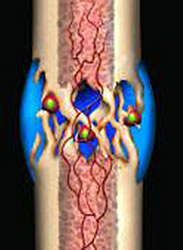Four Days to Three Weeks Following Fracture
The chemical and metabolic reactions that produce the Soft Callus begin a few days after the bone is broken. Fibroblast cells that are present in the Granulation tissue begin to form Cartilage and Fibrocartilage. This is a spongy material that fills the gap between the two fracture fragments, although it remains quite weak to external stresses for around six weeks. For this reason it is important that there is not too much movement of the fracture fragments. The Orthopaedic Consultant will ensure there isn’t too much movement at the fracture site by doing repeat x-rays and making sure that the broken bone remains immobilised with a Sling or Removable Plastic Cast.

Removable Plastic Cast Walkers are commonly used to immobilise injuries such as Metatarsal fractures, a broken leg, a broken ankle or a broken foot. They are much lighter than a plaster cast and allow a greater level of mobility, making it much more comfortable and convenient to wear. Plastic Cast Walkers allow controlled weight bearing which greatly enhances healing and reduces rehabilitation time. Another advantage of Plastic Cast Walkers is that they can be taken off to allow the patient to undertake exercises and therapy. This helps prevent stiffness and muscle wasting.
After a couple of weeks, despite being quite fragile, the Soft Callus provides sufficient stability at the fracture site for new blood vessels to begin forming and for Osteoblasts at the Periosteum (the outer surface of the bone) to begin laying down what is called ‘Woven bone’. This Woven bone at the margins of the fracture is a little soft and disorganised, but it’s the first bone contact between the two fracture fragments.


